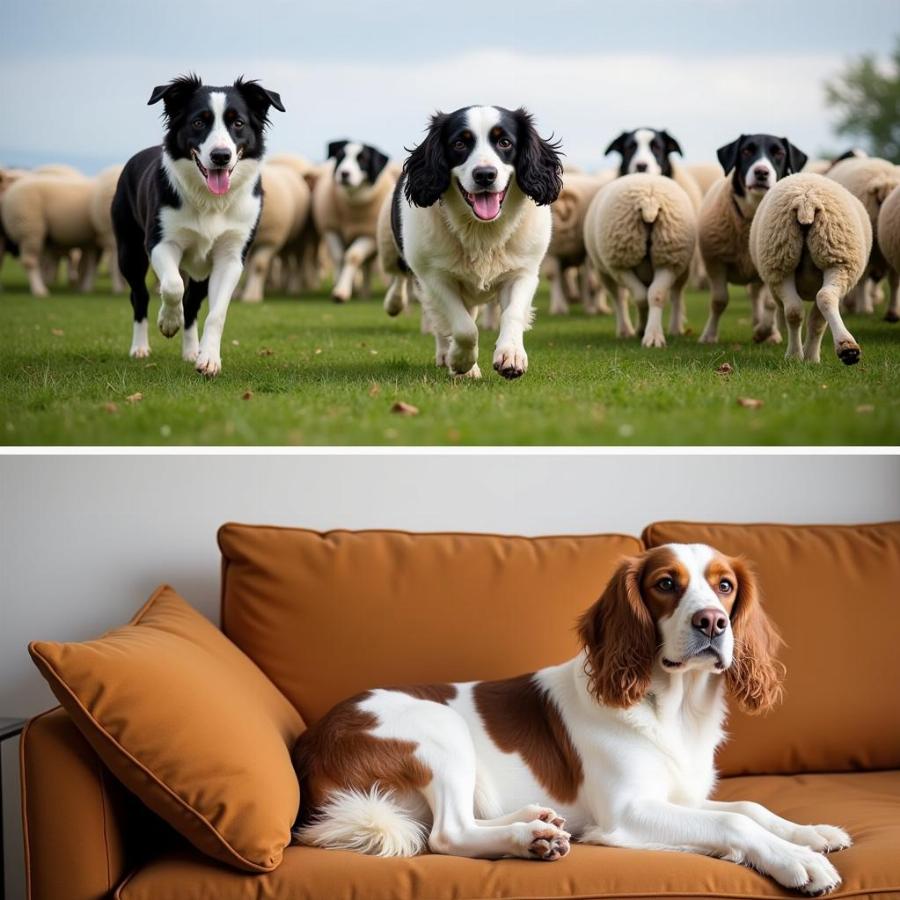Turning a crazy dog into a young master requires patience, consistency, and a deep understanding of canine behavior. It’s a journey of transforming unruly energy into focused obedience, and boisterous antics into refined manners. This transformation isn’t about suppressing your dog’s spirit, but channeling it positively. We’ll explore proven techniques, expert advice, and practical tips to help you guide your energetic companion towards becoming a well-behaved and cherished member of your family.
Understanding Your Dog’s “Craziness”
Before embarking on this training journey, it’s crucial to understand the root of your dog’s “craziness.” Is it breed-specific high energy? Lack of proper socialization? Or perhaps, simply an abundance of youthful exuberance? Identifying the cause will help tailor your training approach for optimal results. For example, a herding breed like a Border Collie will need more mental and physical stimulation than a smaller, less active breed like a Cavalier King Charles Spaniel.
 Understanding Dog's Hyperactivity
Understanding Dog's Hyperactivity
Channeling Energy Through Exercise and Play
A tired dog is a well-behaved dog. Regular exercise is paramount for managing excess energy and promoting calmness. This doesn’t just mean walks around the block. Engage your dog in activities that challenge both their mind and body. Consider agility training, fetch, frisbee, or even scent work. These activities not only burn physical energy but also provide mental stimulation, reducing the likelihood of unwanted behaviors.
Establishing Clear Boundaries and Consistent Rules
Just like children, dogs thrive on structure and routine. Establish clear rules and boundaries from the start. This could be as simple as designating specific areas for sleeping, eating, and playing. Consistency is key. Ensure that everyone in the household enforces the same rules to avoid confusing your dog.
Mastering Basic Obedience: The Foundation of a “Young Master”
Basic obedience training is the cornerstone of transforming a “crazy” dog into a well-behaved companion. Focus on commands like “sit,” “stay,” “come,” and “leave it.” Use positive reinforcement methods, such as treats and praise, to motivate your dog and create a positive learning experience.
“Sit” and “Stay” for Impulse Control
Teaching your dog to “sit” and “stay” helps develop impulse control, a crucial skill for managing excitable behavior. Start with short durations and gradually increase the time as your dog progresses. This will help them learn to control their impulses and become more patient.
“Come” for Reliable Recall
A reliable recall is essential for safety and peace of mind. Practice “come” in a safe, enclosed area, rewarding your dog with enthusiastic praise and treats when they respond. Gradually introduce distractions to make the command more robust.
“Leave It” for Avoiding Trouble
“Leave it” is a valuable command for preventing your dog from getting into trouble. It teaches them to resist the temptation of enticing objects or situations, fostering self-control and responsible behavior.
Socialization: Polishing the “Young Master”
Socialization is essential for developing a well-rounded and well-behaved dog. Expose your dog to a variety of people, places, and other dogs in a controlled and positive manner. This helps them learn to interact appropriately and reduces fear or aggression.
Turning a Crazy Dog into a Young Master: Patience and Persistence
Turning a crazy dog into a young master is a journey, not a destination. It requires patience, persistence, and a genuine commitment to your dog’s well-being. Celebrate small victories along the way, and remember that every dog learns at their own pace.
Conclusion
Transforming a “crazy” dog into a “young master” is achievable with consistent training, clear boundaries, and a loving approach. By understanding your dog’s needs and channeling their energy positively, you can cultivate a strong bond and enjoy the companionship of a well-behaved and cherished member of your family. Remember, this journey requires patience and dedication, but the rewards of a well-mannered companion are immeasurable. Start today and witness the incredible transformation of your furry friend.
FAQ
- How long does it take to train a “crazy” dog? The time frame varies depending on the dog’s age, breed, and individual temperament, but consistency is key.
- What if my dog doesn’t respond to positive reinforcement? Consult a certified dog trainer who can help you identify alternative training methods tailored to your dog’s specific needs.
- Is it ever too late to train an older dog? It’s never too late! Older dogs can still learn new behaviors and benefit from training.
- How can I manage my dog’s energy levels without exhausting myself? Consider puzzle toys, interactive games, and short bursts of intense exercise throughout the day.
- What are some common mistakes to avoid during training? Inconsistency, harsh punishment, and unrealistic expectations can hinder your dog’s progress.
- How do I know if my dog’s “craziness” is a medical issue? Consult your veterinarian if you suspect any underlying health problems contributing to their behavior.
- Where can I find more information about dog training and behavior? turning a crazy dog into a young master chapter 1 can provide you with more detailed insights.
More Questions and Related Articles
Explore do not give what is holy to dogs for more information on canine nutrition and dietary considerations.
About Beaut Dogs
Beaut Dogs is your trusted companion in the world of canine care, offering expert guidance and resources to help you navigate the joys and challenges of dog ownership. From breed selection to training tips and health advice, we empower you to provide the best possible care for your beloved furry friend. When you need support, reach out to us at Email: [email protected] for detailed and accurate assistance from Beaut Dogs.